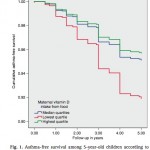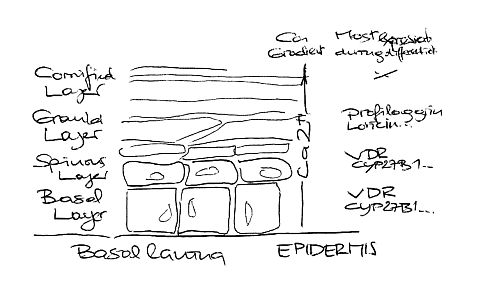There is a new review on vitamin D and allergy.
Reading that piece carefully, I fear that expertise in one area does not guarantee Continue reading More heat than light
There is a new review on vitamin D and allergy.
Reading that piece carefully, I fear that expertise in one area does not guarantee Continue reading More heat than light
 A new study of 5 year old children relates their current allergy symptoms to LOW maternal intake of vitamin D from food (which is strange within the context of current cohort studies that show a INCREASED risk by vitamin D supplement use).
A new study of 5 year old children relates their current allergy symptoms to LOW maternal intake of vitamin D from food (which is strange within the context of current cohort studies that show a INCREASED risk by vitamin D supplement use).
As this is a diabetes study, the sample is highly biased Continue reading Neverending story – vitamin D in pregnancy
A new review [Allergy (2009) vol. 64 (3) pp. 348-353] examines the evidence that
(1) failure to up-regulate the interferon gamma (IFNg) response during infancy is an important determinant of the risk of allergic disease
(2) expression of the IFNg gene in naive T-cells is regulated by epigenetic mechanisms, and
(3) failure to up-regulate IFNg gene expression of naive T-cells associated with low early life microbial exposure.
If we replace “microbial exposure” with Continue reading 1, 2, 3
or briefly vitamin D3. There seems to be another vitamin D /allergy abstract at the forthcoming EAACI congress from the KOALA study. The authors find
Risk for AD was highest for children in the fourth quintile of maternal 25(OH)D level [adjusted odds ratio (aOR) 2.08; 95%CI 1.07-4.03] compared to those in the third quintile; P for trend over the quintiles 0.03]. Continue reading (1S,3Z)-3-[(2E)-2-[(1R,3aR,7aR)-7a-methyl-1-[(2R)-6-methylheptan-2-yl]-2,3,3a,5,6,7-hexahydro-1H-inden-4-ylidene]ethylidene]-4-methylidene-cyclohexan-1-ol
The current issue of the blue journal has more stuff on the vitamin D hypothesis (that has been shifted recently into the opposite direction). I agree with the editorial that
Intervention studies of vitamin D in the primary prevention and treatment of asthma raise a number of difficult scientific, ethical, and regulatory issues.
That may be true while the editorial includes the widely quoted myth that immunological effects occur only at high doses Continue reading Shift happens
Thanks to the great audience in Washington DC watching our pro-con show about vitamin D and allergy. Are you still wondering about all the monkeys on my opponent’s slides? Me too…
With having fever from a flu on the way back to Europe, a picture came to my mind showing the 3 apes that are unable to see, hear and speak …
Mail me if there remain any doubts about the Th1 blocking effect of D3 or go to one of the recent reviews – I have take this for granted as it is even in standard textbooks like Roitt’s Immunology. Continue reading Three unwise monkeys
I had already a thread here about asthma and iatrogenic factors last month including estrogens, vaccines, antibiotics, vitamin D, paracetamol, and Caesarean section. There may be even another kid on the block: folate. At least in mice in utero supplementation with methyl donors enhances allergic airway disease Continue reading Asthma: a iatrogenic disease cont’d
The new Lancet has a paper from our own group as well as another one from ISAAC. We have already suggested earlier that asthma is a iatrogenic disease- the ISAAC paper now confirms at least the long suspected association with paracetamol use – gratulations to my London friend who had been working so long on this hypothesis. The accompanying editorial puts in into context:
Furthermore, although many important potential confounders were included in multivariate analyses, confounding by underlying respiratory disease, differences in hygiene, and use of other antipyretics might also explain the findings.
To put it more on a general level – more iatrogenic factors cannot be excluded, yea, yea.
A new abstract at the recent ATS congress now clears the 2007 controversy between the Camargo and Gale studies on the effect of vitamin D: Wheezing is not asthma (as the atopy component is missing?). Continue reading Not all that wheezes is asthma
Just for curiosity I am collecting a list of allergy genes that are vitamin D dependent. The list is already rather long but now there is a prominent addition: CD14. Known as asthma gene for many years the vitamin D dependency isn’t such clear. A clever analysis, however, now shows that there is an intermediate step involved Continue reading CD 14 now also on the vitamin+allergy list
Despite the known allergy promoting effect of vitamin D in early childhood, there is mounting evidence that it may have beneficial effects during specific immunotherapy. A paper on “IL-10-inducing adjuvants enhance sublingual immunotherapy efficacy in a murine asthma model” by researchers from a French allergen company Continue reading Vitamin D as an adjuvans to specific immunotherapy
During my recent trip to London, I could get a brief glimpse into the 1932 book “Vitamin D” by Reed, Struck and Steck. As this volume is not available in a German library and as it was not allowed by the British library to travel, I took now the lengthy procedures of registering, waiting in the queue, before searching this book for any allergy related items.
It seemed to be worthwile, although with some unexpected results: Continue reading More retro vitamin D
Do you still have some doubts on a recent experiment in mice that were sensitized under vitamin D co-exposure?
Here is another nice paper from Nature, Jan, 21, 1967 where rabbits are fed allergen & vitamin in a germ-free environment Continue reading Vitamin, germs and allergy – 41 years ago
As filaggrin – one of our best atopy genes – is vitamin D dependent, I tried to find out more about epidermal differentiation. The plot here summarizes an earlier review:

There seems to be a clear calcium gradient with the expression of differentiation specific marker in the single strata. So there is some good chance that filaggrin effects may be modified by external vitamin D supply.
For everybody who wants to follow up the most recent discussion about allergy promoting effects of vitamin D here is a short summary. The Harvard group basically wrote three articles that were immediately contradicted. The comment on the first article in JACI was by a NIH researcher Continue reading Vitamania